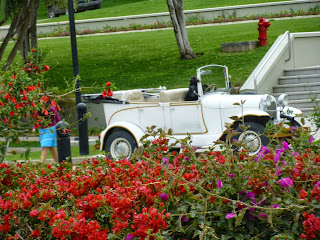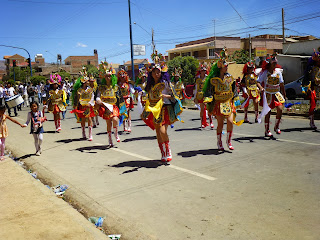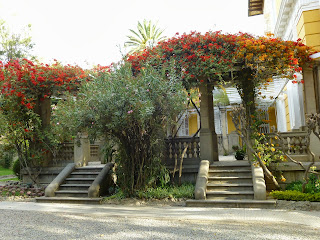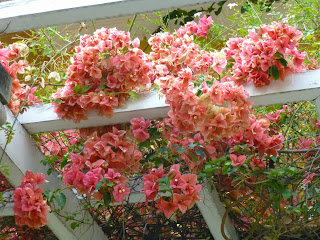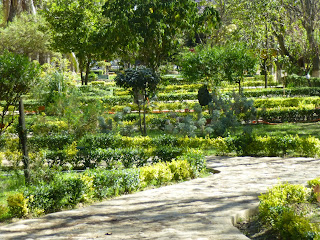One of the most special things about the temple is that marriage therein is not just for "time" ("until death do you part") but for all eternity. The ceremony in the temple is very simple and sacred - no "pomp and ceremony" - but the activities afterward are what you would find anywhere else - i.e., the photos on the temple grounds and then the reception at one of the LDS chapels or at one of many reception halls here in the city. However, on Saturday, the 21st, we saw something new - the bride and groom were driven to the reception in this car! (Frankly, I wouldn't want my beautiful hairdo and/or veil blowing in the wind, but apparently the bride didn't feel that way.) We didn't get to see her, but the driver and car waited in the parking lot just outside the hospedaje so we got a pretty good look at it. He drove up to the front steps of the temple when they signaled him and picked up the bride and groom there. Anybody recognize what kind (and year) the car is?
Sunday, September 22nd, was the first day of spring and there was a HUGE parade in the south part of the city (where we go to church). ALL of the high schools (both private and public, I assume)
and many civic groups participated. The parade began about 10:00 am while we were
still in church (and went right past our building). Most of the schools had a drum corps and a band and they were playing right outside our windows. The bands seem to be primarily made up of cornets and all of them were equally loud and equally out of tune. During choir practice, I could hardly hear my singers and they could hardly hear each other. When we finished choir practice at 1:00 and
started walking up to the main drag to catch our trufi, the parade was STILL going!
We only got pictures of the groups we passed in the 5 blocks we walked,
but I think/hope you’ll find them interesting.
Of course we don't know what any of the costumes were supposed to represent (like the guys in the center right, for instance, or in the second picture, the woman in the center.)
This group had special headdresses; I hope you can blow up the picture big enough to see them.
Other groups were dressed in beautiful outfits but they didn't seem to reflect any kind of historical or cultural images. One thing they all had alike: the boots the girls wore. Can you imagine dancing/marching 3 or 4 miles in those boots?
This group must have had some kind of mythological or historical reference, wouldn't you think? I assume the feathers are supposed to be wings.
This guy (their leader) looks scary from the side . . .
. . . but to me, even scarier from the front!
This was the last group we saw. The parade route turned right and we were going left - across this wide street to stand in front of that brown and yellow building you can see, and catch a taxi home.
One of the hardest things about being here is saying good-bye to other missionary couples who have completed their mission and are heading home. This was a despedida (farewell party) for Bill and Linda Johnson (seated on the right - he's in a suit, her sweater is purple.) We gathered at a place called the "Cine Center" (literally, "Movie Center") which is in the bottom of a big movie theater complex. It's a food court, basically, as you can see from the signs on the wall behind the group. (Dumbo's is a hamburger place.) The couple standing behind Bill and Linda are President and Sister Diaz. He is first counselor in the temple presidency and she is the one who planned this.

All the other people at the table are temple workers - some missionaries (the two Anglos on the left in this picture are the Hursts) - and some local members who serve regular shifts at the temple. Everybody went and ordered their own food and we just sat and visited and took pictures - a pretty easy way to have a party, actually.
Lastly, a picture I should have shared in July. This is a poinsettia tree that we walk past every time we leave our apartment to go shopping - it's at the east end of the lower parking lot. In the middle of winter (July) it had no leaves, as you can see, but still had lots of flowers.
This is what the flowers looked like, close-up. Aren't they gorgeous?
Today when we went grocery shopping I noticed that the tree has been pruned down to nothing but stumps. I guess that's the right thing to do at this time of year, but it looks very sad and definitely not beautiful - which made me remember these pictures and want to share them with you.
That's it for today. Have a great week . . . and vayan con Dios!
